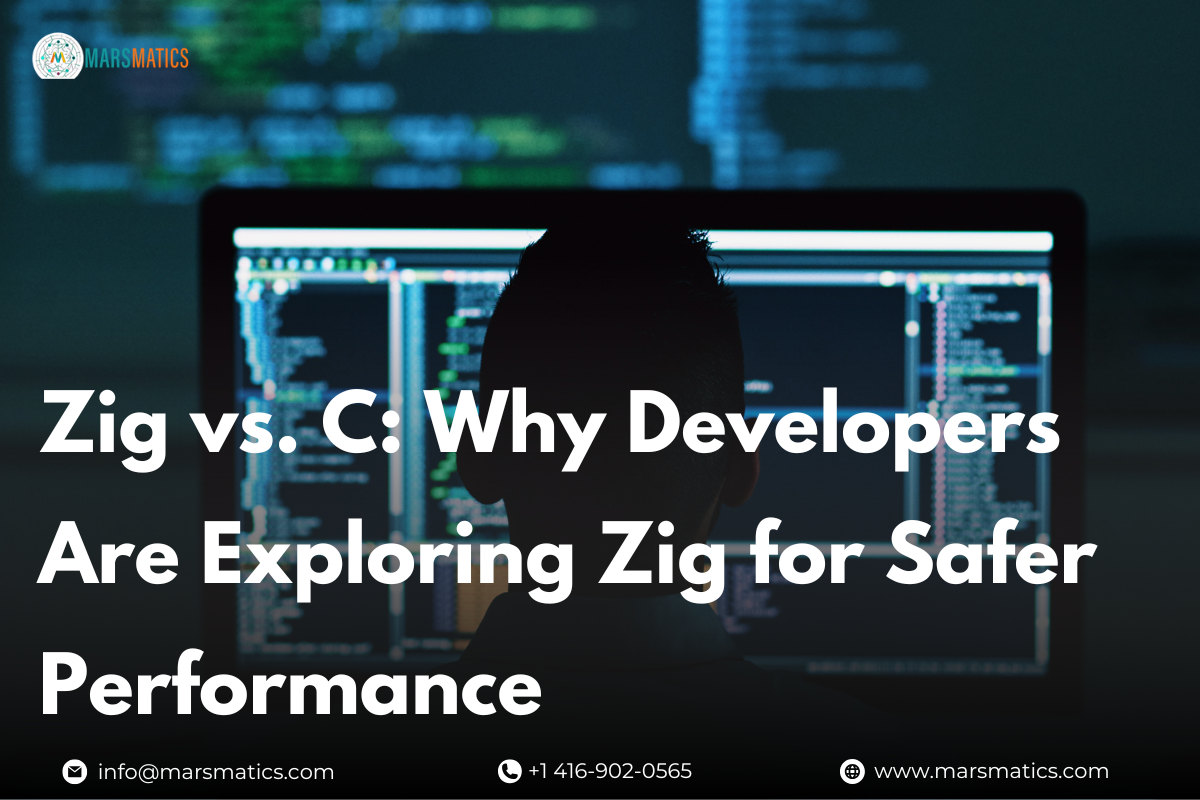Zig vs. C: Why Developers Are Exploring Zig for Safer Performance
When it comes to low-level programming, C has ruled the arena for decades but times are changing. Developers are starting to ask: is there a better way to build fast, efficient, and secure software without all the pitfalls of C? That’s where the Zig programming language enters the picture. In this blog, we’ll explore the rising debate of Zig vs. C and why more developers are giving Zig a serious look for modern systems programming.
What Is the Zig Programming Language?
The Zig programming language is a relatively new low-level language designed for systems programming. Introduced in 2016 by Andrew Kelley, Zig was built with the idea of being a simpler, safer alternative to C, while still offering the control that system-level developers require.
Zig promotes three key principles: simplicity, performance, and safety. Its syntax is clean and minimalist, the compiler is fast and reliable, and it gives developers tools to write secure, predictable code. Unlike higher-level languages, Zig doesn’t use a garbage collector or runtime overhead, making it ideal for operating systems, embedded systems, and other low-level projects.
Notable use cases include game engines, operating systems, and performance-sensitive tools. A prominent example is Bun, a fast JavaScript runtime built in Zig, showcasing its performance capabilities and ease of integration with modern development needs.
Also Read: Cost of Application Software for Startups
How Does C Still Dominate Systems Programming?
Despite newer alternatives, C still holds a dominant position in systems programming. With over 50 years of evolution, C has a mature ecosystem, extensive compiler support, and a deep foundation in operating systems, device drivers, and embedded platforms.
Many critical systems like Linux, Windows components, and microcontroller firmware are written in C. Developers continue to rely on C because of its unmatched performance, portability, and community support.
However, C comes with challenges—most notably undefined behavior, complex manual memory management, and lack of built-in safety features. These issues have caused countless bugs and security vulnerabilities, especially in safety-critical applications. This is where safe systems programming is becoming increasingly important, and Zig presents itself as a practical alternative.
Zig vs. C: Key Differences That Matter:
Memory Safety Without a Garbage Collector:
One of the major Zig language advantages is memory safety without a garbage collector. Unlike C, where developers often run into segmentation faults and buffer overflows, Zig introduces safer ways to manage memory.
It provides bounds checking, optional types, and error union types, which allow better error handling. Instead of relying on global error codes or return values, Zig enables fine-grained control over function outcomes, making debugging and maintenance easier.
Also Read: How AI is Becoming a Co-Pilot, Not Just a Tool?
Simpler Build System:
Another standout difference in the Zig vs. C comparison is the build system. While C depends heavily on Make, CMake, or other complex tools, Zig comes with its own built-in build system. This means developers can manage dependencies, targets, and cross-compilation within the language itself—no need for third-party tools. This simplicity accelerates the development cycle and reduces configuration overhead, especially for new projects.
Cross-Compilation Made Easy:
Zig is often praised as a cross-compilation powerhouse. If you’ve ever struggled to configure a cross-platform toolchain in C, you’ll appreciate what Zig offers. It ships with its own linker and libc implementations, allowing developers to easily compile code for different targets without external dependencies. This advantage makes systems programming in Zig much more accessible, particularly when targeting embedded systems or different architectures.
Better Debugging and Error Messages:
Another developer-friendly feature is Zig’s approach to compiler errors. In C, error messages can be vague and hard to trace. Zig, however, provides detailed, context-aware error messages that guide developers to solutions faster. This improves developer productivity and contributes to a better overall coding experience—another strong Zig language advantage.
When Should You Choose Zig Over C?
If your project requires safe systems programming with minimal performance trade-offs, Zig is worth considering. Developers looking to avoid C’s pitfalls—such as undefined behavior or the complexity of external toolchains—will find Zig to be a more modern, streamlined option.
Zig is particularly well-suited for:
- Writing operating systems or kernels with better safety controls.
- Embedded development where memory control matters.
- Applications requiring secure, clear code with fewer vulnerabilities.
- Cross-platform applications that demand simple setup.
In essence, if you want the power of C without its chaos, systems programming in Zig might be the way forward.
Also Read: AI in the Developer’s Seat: How Coding Tools Are Redefining the Modern Software Workforce
Industry Trends: Is Zig Gaining Traction?
Over the last few years, interest in Zig has grown steadily, especially among indie developers and open-source contributors. Tools like Bun, built in Zig, show that it’s not just a hobbyist language—it’s capable of powering real-world, high-performance applications.
More developers are asking, “Is Zig better than C?”, not just for safety, but also for clarity, maintainability, and modern development practices. The Zig community is also rapidly expanding, with active contributors and regular updates making the language more powerful and stable.
As safety and productivity become bigger priorities in software development, languages like Zig that offer safe systems programming without sacrificing performance are increasingly being adopted.
Final Thoughts — Zig or C?
Choosing between Zig and C depends on your project goals. C remains the king for legacy systems, OS kernels, and projects that require massive ecosystem support. However, if you’re starting a new project and want modern features, cleaner syntax, and built-in safety tools, Zig programming language is a strong contender. Its advantages—like easy cross-compilation, clearer error handling, and memory safety—can lead to faster development and fewer bugs.
So, is Zig better than C? For many new and performance-critical applications, it just might be. As the language matures and more developers adopt it, the case for switching grows stronger. Zig doesn’t aim to replace C outright, but to offer a smarter, safer alternative. And in 2026, that’s exactly what many developers are looking for.
FAQs
Q1: Is Zig faster than C?
In many scenarios, Zig delivers performance that closely matches or even exceeds C. However, its focus isn’t just raw speed—it also provides safer and more predictable outcomes, improving development confidence and security.
Q2: Is Zig good for embedded systems?
Absolutely. Thanks to its small binary size and low-level control, Zig is a strong candidate for embedded development. Its ability to simplify cross-compilation is a huge bonus.
Q3: Can Zig replace C in all projects?
Not yet. While Zig offers many benefits, C’s massive ecosystem and long-standing dominance mean it will continue to play a role in legacy and enterprise projects. But Zig is ideal for greenfield, modern development efforts.
Q4: Is it hard to learn Zig if you know C?
Not at all. If you’re familiar with C, transitioning to Zig is relatively straightforward. The syntax is similar, but Zig adds modern tooling and better safety mechanisms to make your development journey smoother.








